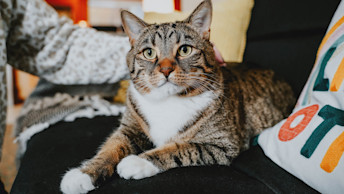March 23, 2022
Signs Your Cat Has Anxiety and What You Can Do About It

Our cats communicate with us through their behaviour. When they exhibit unusual behaviour, it is often their way of signaling that something is wrong.
As humans, when we are uncertain or scared of the world around us, we often experience anxiety. Anxiety is when we’re not in immediate danger, but our body and mind think we might be.
Cats experience the same anxiety in anticipation of possible danger. This manifests itself in your cat’s bodily reactions and behaviours. As cat parents, we need to recognize these signals and know how to act.
In this article, we will talk about what causes anxiety in cats, what to look for, and how you can help an anxious cat.
What causes anxiety in cats?
Cat anxiety often comes from one or more of these stimuli:
Illness or pain: Pain can be a powerful stimulus that can trigger anxiety or aggravate existing anxiety.
Trauma: Your pet may have been almost run over by a car and now gets anxious when they hear a car drive by. Or a smell or sound may remind them of a past traumatic event and trigger anxiety.
Lack of socialization: Cats need social stimulation, especially while they’re kittens. If not, this could lead to anxiety around new people and pets in the future.
Separation Anxiety: This is common in cats. This may result from being rehomed many times or having a history of being abandoned. It may also be that they get used to having someone (or another pet around), and then that person or pet is then away for an extended period.
Any other changes in your cat’s life (moving, new family members, irregular routines) can also trigger or exacerbate their anxiety.
Signs of cat anxiety
Anxiety can be mild to severe.
Some general signs of cat anxiety include:
- Elevated heart and breathing rates
- Excessive panting
- Trembling
- Salivation
- Extreme vocalization
You may notice your cat avoiding eye contact with you or physically shifting away. They may also hold their tail closer to their body. You may also notice that they are more skittish or freeze in place when their feeling anxiety.
Anxiety can start to show early in a cat’s life, often between 5 months and 1 year, but can come anytime after experiencing a trauma. As soon as you notice signs of trauma or anxiety, talk to your vet. Try to determine what’s causing it so you can remove that stimulus from their environment or help them cope.
How you can help
If your cat shows signs of anxiety, see your vet as soon as possible to see if it’s triggered by a physical illness.
Then, you can help comfort your cat by following the tips below.
Comforting them
Your cat loves you. The best thing you can do when they feel anxious is comfort them. This does not reward fearful behaviour, but it tells your cat that you are there to keep them safe.
Never punishing them
Negative reinforcement is not helpful for any pet, especially an already fearful cat. This can make the fear stronger and could provoke aggression.
Not confining them
No one wants to feel physically trapped when experiencing anxiety. Give your cat as much space as possible and avoid locking them in a room or a cat carrier. This can make them feel even less in control, triggering an increase in anxiety and aggression.
Feeding them a healthy diet
When your cat is physically healthy, they can better manage and control their emotions and responses to unpleasant stimuli. Go! Solutions dry and wet food recipes for cats are a premium cat food to help you cat look and feel their best.
Conclusion
Your cat is likely looking to you to help them get through their anxiety. While you may not entirely rid them of their fear, being a positive, regular presence in their lives can act like a rock in their life.
Once you learn to recognize cat anxiety symptoms, you can be better prepared to give them the support they need to live a happy life.


